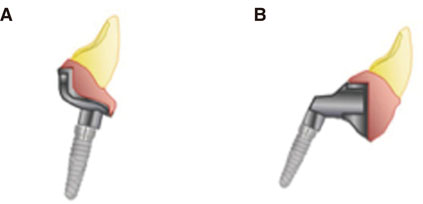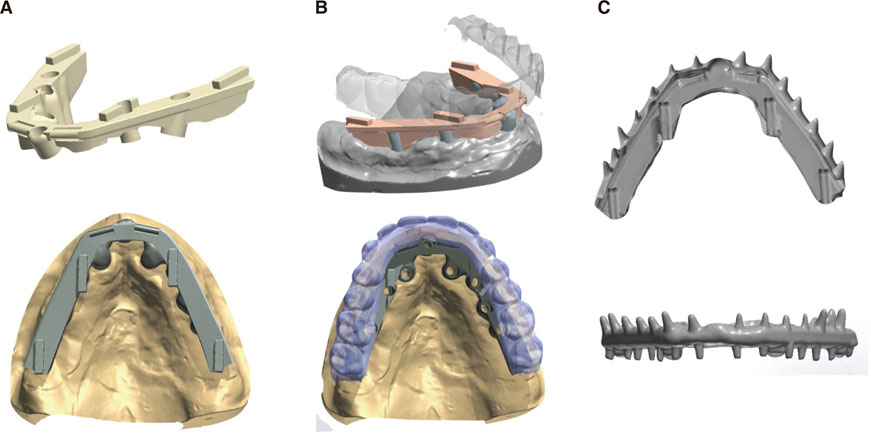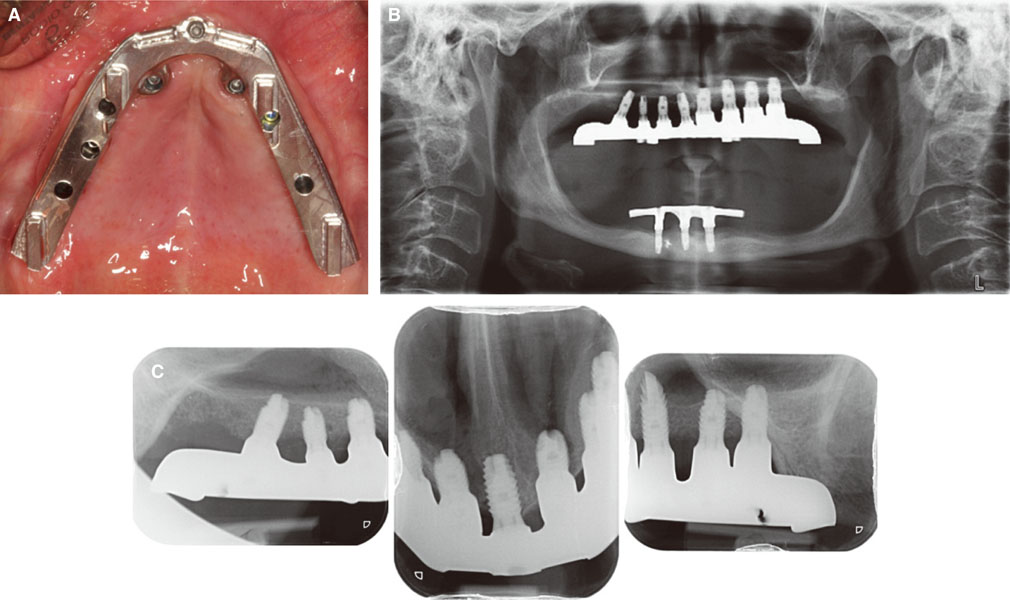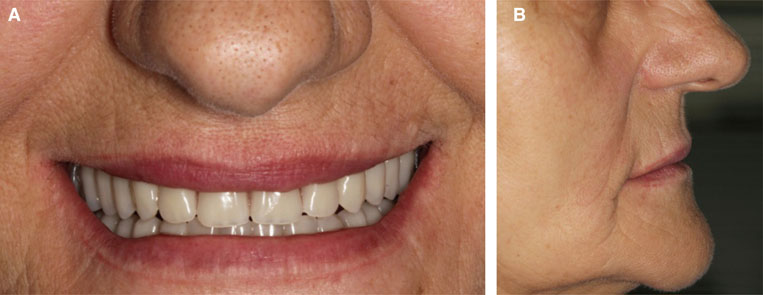J Adv Prosthodont.
2015 Jun;7(3):264-270. 10.4047/jap.2015.7.3.264.
Implant-supported overdenture manufactured using CAD/CAM techniques to achieve horizontal path insertion between the primary and secondary structure: A clinical case report
- Affiliations
-
- 1Department of Stomatology, Faculty of Medicine and Dentistry, Valencia University, Spain.
- 2Department of Buccofacial Prostheses, Faculty of Dentistry, Madrid Complutense University, Spain.
- 3Oral Surgery, Faculty of Medicine and Dentistry, Valencia University, Spain. Miguel.penarrocha@uv.es
- KMID: 2284713
- DOI: http://doi.org/10.4047/jap.2015.7.3.264
Abstract
- This report describes the case of an edentulous patient with an atrophic maxilla and severe class III malocclusion. Prosthetic rehabilitation was performed using CAD/CAM techniques for manufacturing an implant-supported overdenture with horizontal insertion. A vestibulo-lingual insertion overdenture is a precision prosthesis with a fixation system affording a good fit between the primary and secondary structure. Both structures exhibit passive horizontal adjustment. This treatment option requires the same number of implants as implant-supported fixed dentures. The horizontal assembly system prevents the prosthesis from loosening or moving in response to axial and non-axial forces. The technique was used to rehabilitate a patient presenting an atrophic upper maxilla, with the insertion of 8 implants. No complications were reported at follow-up 3, 6 and 12 months after fitting of the prosthesis. This system offers solutions to the clinical and laboratory complications associated with hybrid prostheses, concealing emergence of the chimneys and improving implant-prosthesis hygiene.
Keyword
MeSH Terms
Figure
Cited by 1 articles
-
Precision of the milled full-arch framework fabricated using pre-sintered soft alloy: A pilot study
Hyun-Wook Woo, Sung-Am Cho, Cheong-Hee Lee, Kyu-Bok Lee, Jin-Hyun Cho, Du-Hyeong Lee
J Adv Prosthodont. 2018;10(2):128-131. doi: 10.4047/jap.2018.10.2.128.
Reference
-
1. Slot W, Raghoebar GM, Vissink A, Huddleston Slater JJ, Meijer HJ. A systematic review of implant-supported maxillary overdentures after a mean observation period of at least 1 year. J Clin Periodontol. 2010; 37:98–110.2. Sadowsky SJ, Caputo AA. Effect of anchorage systems and extension base contact on load transfer with mandibular implant-retained overdentures. J Prosthet Dent. 2000; 84:327–334.3. Almasri R, Drago CJ, Siegel SC, Hardigan PC. Volumetric misfit in CAD/CAM and cast implant framework: a university laboratory study. J Prosthodont. 2011; 20:267–274.4. Eliasson A, Wennerberg A, Johansson A, Ortorp A, Jemt T. The precision of fit of milled titanium implant frameworks (I-Bridge) in the edentulous jaw. Clin Implant Dent Relat Res. 2010; 12:81–90.5. Örtorp A, Jemt T. CNC-milled titanium frameworks supported by implants in the edentulous jaw: a 10-year comparative clinical study. Clin Implant Dent Relat Res. 2012; 14:88–99.6. Solá-Ruíz MF, Agustin-Panadero R, Fons-Font A, Labaig-Rueda C. An implant-supported overdenture design with a horizontal path of insertion. J Prosthet Dent. 2013; 110:239–242.7. Katsoulis J, Brunner A, Mericske-Stern R. Maintenance of implant-supported maxillary prostheses: a 2-year controlled clinical trial. Int J Oral Maxillofac Implants. 2011; 26:648–656.8. Papaspyridakos P, Lal K. Computer-assisted design/computer-assisted manufacturing zirconia implant fixed complete prostheses: clinical results and technical complications up to 4 years of function. Clin Oral Implants Res. 2013; 24:659–665.9. Kapos T, Evans C. CAD/CAM technology for implant abutments, crowns, and superstructures. Int J Oral Maxillofac Implants. 2014; 29:117–136.10. Tahmaseb A, De Clerck R, Aartman I, Wismeijer D. Digital protocol for reference-based guided surgery and immediate loading: a prospective clinical study. Int J Oral Maxillofac Implants. 2012; 27:1258–1270.11. Sanna AM, Molly L, van Steenberghe D. Immediately loaded CAD-CAM manufactured fixed complete dentures using flapless implant placement procedures: a cohort study of consecutive patients. J Prosthet Dent. 2007; 97:331–339.12. Komiyama A, Klinge B, Hultin M. Treatment outcome of immediately loaded implants installed in edentulous jaws following computer-assisted virtual treatment planning and flapless surgery. Clin Oral Implants Res. 2008; 19:677–685.13. Brånemark PI, Svensson B, van Steenberghe D. Ten-year survival rates of fixed prostheses on four or six implants ad modum Brånemark in full edentulism. Clin Oral Implants Res. 1995; 6:227–231.14. den Dunnen AC, Slagter AP, de Baat C, Kalk W. Adjustments and complications of mandibular overdentures retained by four implants. A comparison between superstructures with and without cantilever extensions. Int J Prosthodont. 1998; 11:307–311.15. Semper W, Heberer S, Nelson K. Retrospective analysis of bar-retained dentures with cantilever extension: marginal bone level changes around dental implants over time. Int J Oral Maxillofac Implants. 2010; 25:385–393.16. Rashid F, Awad MA, Thomason JM, Piovano A, Spielberg GP, Scilingo E, Mojon P, Müller F, Spielberg M, Heydecke G, Stoker G, Wismeijer D, Allen F, Feine JS. The effectiveness of 2-implant overdentures - a pragmatic international multicentre study. J Oral Rehabil. 2011; 38:176–184.17. Assunção WG, Barão VA, Delben JA, Gomes EA, Tabata LF. A comparison of patient satisfaction between treatment with conventional complete dentures and overdentures in the elderly: a literature review. Gerodontology. 2010; 27:154–162.18. Melilli D, Rallo A, Cassaro A. Implant overdentures: recommendations and analysis of the clinical benefits. Minerva Stomatol. 2011; 60:251–269.19. Rossetti PH, Bonachela WC, Rossetti LM. Relevant anatomic and biomechanical studies for implant possibilities on the atrophic maxilla: critical appraisal and literature review. J Prosthodont. 2010; 19:449–457.20. Ueda T, Kremer U, Katsoulis J, Mericske-Stern R. Long-term results of mandibular implants supporting an overdenture: implant survival, failures, and crestal bone level changes. Int J Oral Maxillofac Implants. 2011; 26:365–372.
- Full Text Links
- Actions
-
Cited
- CITED
-
- Close
- Share
- Similar articles
-
- Rehabilitation of edentulous maxilla with implant-supported milled bar overdenture using CAD/CAM customized abutment: A case report
- Rehabilitation using mandibular implant overdenture with CAD/CAM milled bar: A case report
- Maxillar implant-retained overdenture using CAD/CAM milled zirconia bar with PEKK sleeve: a case report
- Mandibular implant-supported overdenture using CAD-CAM Konus type attachment: A case report
- Use of polyaryletherketone (PAEK) based polymer for implant-supported telescopic overdenture: A case report







